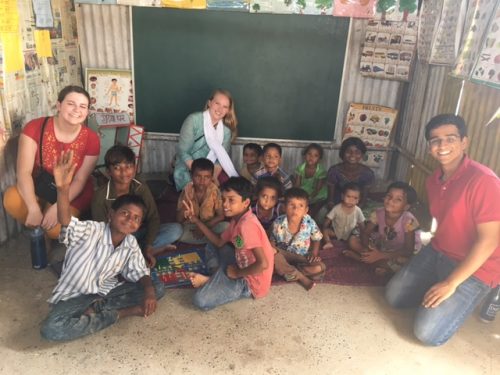
After 15 years in the United States education system, I thought I had at least a general understanding of life in other countries. I still remember sitting in my AP Human Geography class during freshman year of high school; I was learning so much about the way people live. Of course, we discussed India in depth in regards to migration, urbanization, population growth rate, health care, etc. I foolishly assumed that my foundational knowledge of urban slums in India was decent since my exposure went beyond the depictions in Slum Dog Millionaire.
Even after being in Ahmedabad for just over a week, I can wholeheartedly say I was totally wrong. I perceived slums as a dangerous place to live and pitied these people because I assumed they would rather live anywhere else; I viewed slum dwellers as destitute and homeless. I thought I was coming to Ahmedabad to do charity work. Through my Western, American, and privileged lens, I thought slum dwellers needed welfare because they couldn’t support themselves. I am so grateful the staff at Saath Charitable Trust took the time to educate me and introduce me to their community partners, the inspiring people that reside in slum pockets of Ahmedabad.
Slum does not equal homeless. Anywhere from 40-60% of Ahmedabad’s population lives in a slum community at a given time. The people in the slums pay rent for their homes, have jobs, and want to improve their communities. Mr. Rajendra Joshi, the founder of Saath, spoke to all the DukeEngage India-Ahmedabad program on Friday, June 23rd, and this was a key point he addressed. Mr. Joshi said that Saath began as a youth group playing volleyball in one slum here in Ahmedabad. After volleyball, he would talk to the young people and asked them what they wanted to see changed about their communities. That’s when the Integrated Slum Development project was born. These young people said that the biggest issues their community faced was lack of infrastructure. Because slum fall into the gray area of the informal housing sector, there is no precedent on how municipal governments can provide infrastructure, or even if it was possible. When asked how Saath could help change that, these young people went out into their community, going door to door, to ask people if they would be willing to pay for a proper plumbing system. Almost unanimously the residents of the slum agreed that plumbing was necessary and they were not only willing, but capable to contribute financially.
Saath helped sponsor a pilot program for low cost plumbing in this slum pocket. It would cost 6,000 Rupees ($93) for each household to receive running water and plumbing. Saath facilitated an agreement between the slum community, the municipal government, and a corporate donor so that the cost would be divided equally amongst the three. Each household would pay 2,000 Rupees ($31) and the other 4,000 Rupees would come from the municipal government and local corporate donor. Because of this community effort, Saath assisted in getting approximately 700 households and 49 slum pockets the infrastructure they needed.
If you give a man a fish, he will eat for a day. If you teach a man to fish, he will only eat for a lifetime if he lives near a body of water with a lot of fish and can afford the market rate of fishing poles and bait. If you ask a young person what they would like to change in their community, and offer guidance, they will make it happen.
Saath didn’t stop there, they continued this approach of community needs based assessments to facilitate affordable electrical connections in over 5,000 households. After the initial 1,200 home pilot, there was 100% compliance with paying the monthly bill and the electrical company permanently lowered the initial connection cost to 5,000 Rupees from the original 10,000 Rupees. Community contribution has been a part of Saath’s model from the beginning. The financial contribution empowers the slum dwellers to improve their community because they finally gain a sense of ownership and accountability.
Today Saath has grown into a full-fledged NGO that employs 300 people and continues to empower the entire community of Ahmedabad. When I asked Mr. Joshi what he thinks is the best approach to an eventual goal of eliminating slum pockets in Ahmedabad his opinion was insightful and unique; he said he does not agree with the philosophy that we should attempt to shift all of the people out of the slums at once and raze this communities. He believes that the most sustainable approach is to slowly develop the slums and help these communities gain access to the resources from which they have been systematically excluded. Instead of trickle down, Saath subscribes to the bottom up mentality with an emphasis on market-based strategies for addressing the needs of urban and rural populations.
Saath has been working on this inclusive development approach since 1989; 27 years later with over 40 active and completed projects, Saath aids in almost all aspects of community development. Everything this organization does stems from its original mission, from those chats after volleyball games: community needs assessments. Saath is the Hindi term for together, society, and friendship.
Slum does not equal homeless. Slum does not equal people looking for a loop-hole and a way out of civic contribution. Slum does not equal a problem that needs solving. Slum equals a step in the right direction towards ending homelessness. Slum equals a motivated community that is happy and thankful for what they have. Slum equals parents migrating for work so they can save for their child’s education. Slum equals affordable housing for rural farmers and their families with dreams of living in the urban community. Slum equals the happiest and most grateful children I have had the honor of meeting.
